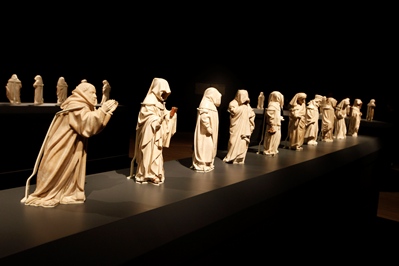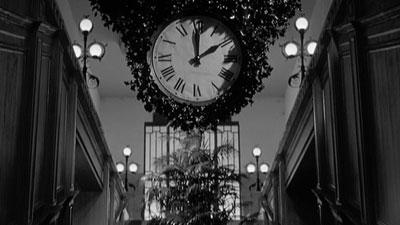After its much ballyhooed 24-hour screening in the Bing Theater last month, Christian Marclay's epic film collage The Clock was moved to a smaller gallery space in the nearby Art of the Americas Building, where it is on view every day during regular museum hours through the end of July. I'd watched many hours' worth of the piece during the inaugural screening at LACMA, but after hearing the news that Marclay has been awarded the prestigious Gold Lion at this year’s Venice Biennale for The Clock, I decided to pass the time once more, in its new setting.
It’s easy to get caught up in The Clock. It hurtles ever-forward, constantly telling you how many minutes you’ve spent sitting in the dark as the day goes by outside. The Clock is often ominous, usually anxious, sometimes cavalier, and occasionally breezy. Depending on when you watch—not only what time of day, but also your proximity to the top of the hour—the ride can become quite exhilarating. Approaching the hour, the characters on screen are nervously approaching some moment of truth—a deadline, a standoff, a showdown—while just past the hour new characters are scrambling to get to something they’re in danger of missing—a bus, a test, an interview.

Christian Marclay, The Clock (still), 2010, purchased with funds provided by Steve Tisch through the 2011 Collectors Committee
The more you watch, the more The Clock seems to be fixated not so much on the time but on your time. Seconds are passing, minutes, hours. Soon the day will be done—soon your day will be done! Time is ticking. You can’t stop time from ticking. Even if you walk out of The Clock, there’s still a watch in your pocket, a sun in the sky, the earth revolving. The Clock is thousands of clips moving at a clip. The faster it goes, the more inevitable its conclusion. A character in a scene from The Twilight Zone, which occurs a little after 2 pm, puts it most succinctly: “When my clock stops ticking, I’ll die.”
That’s why it’s such an apt juxtaposition, coincidentally or not, with The Mourners: Tomb Sculptures from the Court of Burgundy, on view in the adjacent gallery. The thirty-seven small sculptures on view originally ringed the tomb of John the Fearless, who died in 1419. The figures were placed in a processional around the tomb in a state of eternal sorrow and prayer.

Installation view of The Mourners, photo by Steve Cohn
In other words, no clocks necessary. The installation for The Mourners is intimate, dimly lit, and serene. Standing in the gallery with the sculptures, you can feel the rhythms of your body slow as you look at each of the individual figures carved from alabaster, each with their own personality and body language. Most of the figures’ eyes are downcast, if their heads aren’t altogether concealed by their cloaks. A few look upward, as if they’ve just heard their names called. One, amusingly, holds his nose—stench of death, see. The closer you look at each Mourner, the more powerful the exhibition becomes. It’s in the details of their faces: some are sorrowful, some are solemn; others are pious, regal, resigned—resilient!—bold, or baleful.
Sitting in the mini-theater setting of The Clock is a heady rush of imagery and sound which at times feels, not quite literally, like life is passing before your eyes (Hollywood’s gussied-up version of life, at least). Standing amidst the tomb sculptures of The Mourners, on the other hand, you might find the serenity and peace to contemplate what it all amounts to. From these two darkened galleries, you’re then at liberty to return to the daylight and go on living in the here and now.
Scott Tennent



